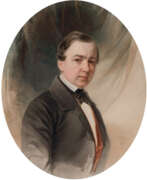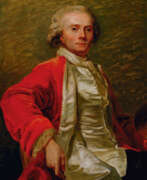Miniaturists Self-portrait


Woldemar Hau (Russian: Владимир Иванович Гау) was a Baltic German portrait painter, renowned for his contributions to the Biedermeier style, a period marked by a sense of realism and simplicity in art. Born in 1816 in Tallinn, then part of the Russian Empire, he was trained under the guidance of his father, Johannes Hau, and the distinguished artist Karl von Kügelgen. Hau's remarkable talent became evident early on when, at just sixteen, he was recommended to paint for the Russian Imperial Court, leading to his appointment as a Court Painter.
During his illustrious career, Hau captured the visages of the Russian nobility, including Tsar Nicholas I and Tsarina Alexandra Fyodorovna, alongside other key figures of his time. His works, often characterized by their intricate detail and vibrant realism, include over 200 miniature portraits of the Izmaylovsky Regiment veterans. His most celebrated works are preserved in prestigious collections and reflect his mastery in both watercolours and miniatures on ivory.
For those interested in exploring the legacy of Woldemar Hau, his paintings are a fascinating window into the cultural and historical nuances of 19th-century aristocratic Russia. To stay updated on exhibitions and auctions featuring Hau's work, I encourage you to sign up for updates. This subscription will keep you informed about new sales and auction events specifically related to Woldemar Hau.


Jean-Laurent Mosnier was a French painter and miniaturist, renowned for his detailed and polished portraitures during the Ancien Régime. Born in Paris in 1743, Mosnier quickly ascended to become a court painter, notably serving Marie Antoinette. His mastery in miniature painting earned him significant acclaim, leading to a prosperous career across various European cities, including London, Hamburg, and St. Petersburg, after fleeing France due to the Revolution.
Mosnier's works are recognized for their exquisite attention to texture and fabric, skills likely honed during his early training at the Académie de Saint-Luc. He became a member of the Académie Royale in 1788, where his works, such as portraits of prominent academicians, solidified his reputation. His career spanned various shifts in his geographical and political contexts, adapting his artistic style to suit the tastes of his diverse clientele, including various European aristocrats and members of the Russian imperial family.
Several of Mosnier's significant works are housed in prestigious museums, including the Louvre and The Metropolitan Museum of Art, ensuring his legacy within the annals of European art history. For art collectors and enthusiasts interested in the rich history and exquisite craftsmanship of Jean-Laurent Mosnier's works, keeping updated on exhibitions and sales is invaluable. Sign up for updates on new product sales and auction events related to Jean-Laurent Mosnier to enhance your collection and appreciation of this distinguished artist.





